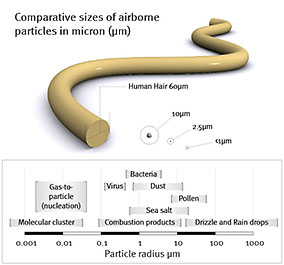Particles
Airborne particles are particles present in the air at elevated levels where they can be hazardous to human health or cause a nuisance. Potential health effects of airborne particles are closely related to particle size.
The most common particle size distributions monitored are:
- PM2.5 (particles less than 2.5 micrometres in diameter) – for assessment against health-based criteria
- PM10 (particles less than 10 micrometres in diameter) – for assessment against health-based criteria
- TSP (total suspended particles, generally up to 100 micrometres in diameter) – for assessment against predominantly nuisance-based criteria
- deposited dust particles – for assessment of dust nuisance.
PM10 and PM2.5 particles are invisible to the naked eye. By way of comparison, a human hair is about 60 micrometres in diameter.


Visibility-reducing particles (aerosols) are also monitored to assess loss of visual amenity (the distance one is able to see clearly).
Sources of airborne particles
Airborne particles can come from:
- combustion processes, such as engines, power stations, wood heaters, bushfires and hazard reduction burning
- non-combustion activities, such as earthworks, unpaved roads, bulk material handling and windblown dust.
Monitoring airborne particles
The Queensland Government monitors airborne particles in South East Queensland, South West Queensland, Wide Bay-Burnett, Gladstone, Central Queensland , North Queensland, Townsville, Far North Queensland and Mount Isa.
Particles are sampled at regular intervals using high and low volume air samplers, or monitored continuously using a tapered element oscillating microbalance or instruments using a light-scattering technique.
Visibility-reducing particles are measured using a nephelometer.
Deposited dust is measured using a dustfall deposit gauge.
PM2.5
PM2.5 refers to airborne particles less than 2.5 micrometres in diameter.
These particles are mainly generated by combustion processes, such as motor vehicle engines, industrial boilers, solid fuel heaters and fires.
Health effects
PM2.5 particles are capable of penetrating the lower airways of humans and can cause possible negative health effects.
Air quality guidelines
Commencing 1 January 2025, the Environmental Protection (Air) Amendment Policy 2024 (EPP Air) objectives for PM2.5 are:
- 20 micrograms per cubic metre (µg/m3) for a 24-hour exposure period
- 7 µg/m3 for an annual exposure period.
Commencing 1 January 2025, the National Environment Protection (Ambient Air Quality) Measure standards for PM2.5 are:
- 20 micrograms per cubic metre (µg/m3) for a 24-hour exposure period
- 7 µg/m3 for an annual exposure period.
These guidelines are designed to protect sensitive members of the community, such as children and asthmatics.
Typical outdoor PM2.5 levels are well below the 24-hour standard. Smoke from fires and dust storms are a common cause of elevated PM2.5 concentrations.
PM10
PM10 refers to airborne particles less than 10 micrometres in diameter.
These particles are generated by combustion and non-combustion processes, including windblown dust, sea salt, industrial processes, motor vehicle engines and fires.
Health effects
PM10 particles are capable of penetrating the lower airways of humans and can cause negative health effects.
Air quality guidelines
The Environmental Protection (Air) Policy 2019 (EPP Air) objectives for PM10 are:
- 50 micrograms per cubic metre (µg/m3) for a 24-hour exposure period
- 25 µg/m3 for an annual exposure period.
The National Environment Protection (Ambient Air Quality) Measure standards for PM10 are:
- 50 micrograms per cubic metre (µg/m3) for a 24-hour exposure period
- 25 µg/m3 for an annual exposure period.
These guidelines are designed to protect sensitive members of the community, such as children and asthmatics.
Typical outdoor PM10 levels are well below the 24-hour standard.
TSP
Airborne particles up to about 100 micrometres in diameter are referred to as TSP (total suspended particles).
These particles are generated by combustion and non-combustion processes, including windblown dust, sea salt, earthworks, mining activities, industrial processes, motor vehicle engines and fires.
Health and nuisance effects
Health effects associated with TSP mainly arise from the fraction of particles less than 10 micrometres in diameter which are capable of penetrating the lower airways of humans.
Particles larger than 10 micrometres in diameter are not generally associated with human health effects. However, these particles can cause nuisance problems through soiling of property and materials.
Air quality guidelines
The Environmental Protection (Air) Policy 2019 (EPP Air) objective for TSP for protection of human health is 90 micrograms per cubic metre for an annual exposure period.
The New Zealand Ministry for the Environment recommends that 24-hour average TSP levels are below 60 µg/m3 in residential areas to avoid dust nuisance impacts.
Outdoor TSP levels are typically well below the 24-hour dust nuisance trigger level.
Visibility-reducing particles
Aerosols and fine particles can reduce visibility. Smoke from fires or haze are common causes of poor visibility. In Brisbane, the closing of metropolitan power stations in 1986 and the banning of backyard burning in 1987 significantly reduced fine particle levels and improved visibility.
Air quality guidelines
The Environmental Protection (Air) Policy 2019 (EPP Air) objective for visibility-reducing particles is a visibility of 20 kilometres over a 1-hour period.
Deposited dust
Deposited dust (dustfall) refers to air particles that settle out over a given area and time under the influence of gravity.
Deposited dust can include particles of any size, but it generally comprises particles larger than 20 micrometres in diameter that rapidly settle out of the air near the point of emission. It is measured to assess if an emission source is causing a nuisance, such as soiling of property and materials.
Air quality guidelines
Deposited dust is associated with nuisance effects. The Environmental Protection (Air) Policy 2019 does not specify an objective for deposited matter, but a level of 120 milligrams per square metre per day (mg/m2/day), averaged over one month, is commonly used to assess dust nuisance.
More information
View the live air data service to check the current levels of particles in the monitoring network.


